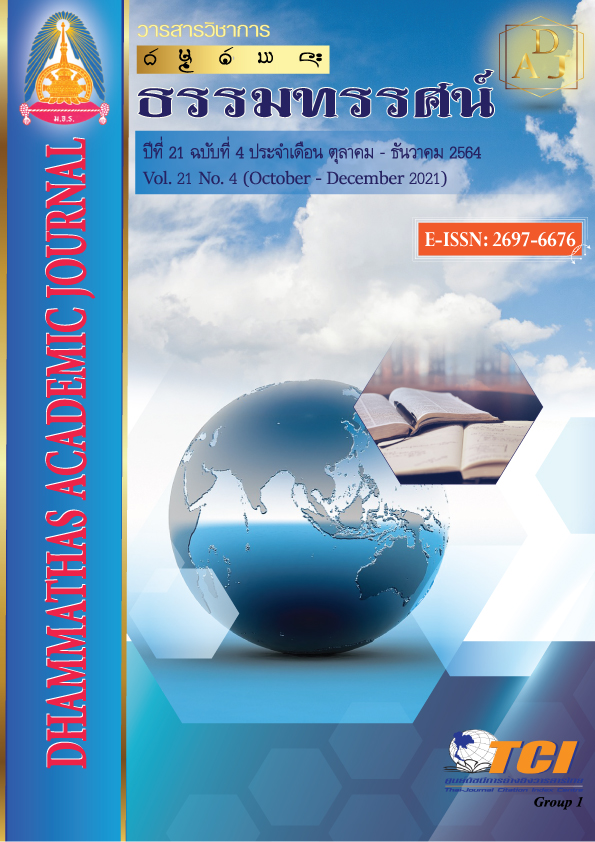The Students’ Problem Posing Process in classroom by Using Lesson Study and Open Approach
Main Article Content
Abstract
The purpose of study is to analyze the students’ problem posing process in classroom by using lesson study and open approach. It's qualitative research the target group was 10 sixth grade students, the second Semester of 2020 school years at Chongmaew Pittaya School, Nakhon Ratchasima Province. The data collection was using lesson plans about the ratio, filed note. The collected data was analyzed by Inprasitha framework.
The study found that: a collaborative lesson plan design, the lesson study team designed the lesson plan, that predict from the students’ problem posing process, which related to situations by using the ratio that the students familiar in daily life, designed the semi concrete aids to represent for the ratio, and using mathematical symbols to represent for the ratio. 2) A collaborative teaching observation in Phase 1: Problem Posing was found the students are curious that show from observing, gesticulation, express one’s opinion, and curious to solution about the ratio. In addition, also was found the students are problem posing: Step 1 The representations of the real world: the students interested and observed in familiar situation about the ratio, Step 2 The semi concrete aids: the students used media and image to represent about the ratio in situation, by show from behavior or speech that tried to change the situation for more understanding about the ratio, and Step 3 The representations of mathematical world: the students transformed situation then show talking or writing behavior about mathematical symbol, that writing to represent about the ratio. Phase 2 Problem Solving: the student collaborated problem solving by talking about problem posing, then present idea in the classroom, and summarized idea about the ratio. 3) The collaborative lesson reflection teaching, the lesson study team reflected in problem posing process about the ratio, and improved the teaching to promote the students’ problem posing and solve problems about the ratio by yourself.
Article Details
References
นภสร บุญเสนา. (2563). การมีปัญหาของตนเองของนักเรียนในชั้นเรียนที่ใช้นวัตกรรมการศึกษาชั้นเรียนและวิธีการแบบเปิด. การประชุมวิชาการเสนอผลงานวิจัยระดับบัณฑิตศึกษาแห่งชาติ ครั้งที่ 21, (หน้า 709-718). ขอนแก่น: มหาวิทยาลัยขอนแก่น.
ไมตรี อินทร์ประสิทธิ์. (2557). กระบวนการแก้ปัญหาในคณิตศาสตร์ระดับโรงเรียน. ขอนแก่น: เพ็ญพรินติ้ง.
_______. (2559). การวิจัยและพัฒนาการสอนคณิตศาสตร์แนวใหม่. KKU Research, 2, 2-9.
_______. (2563). สถานการณ์ในการศึกษา ณ ปัจจุบัน และนวัตกรรมศึกษาชั้นเรียนและวิธีการแบบเปิด [เทปบันทึกเสียง]. ขอนแก่น: มหาวิทยาลัยขอนแก่น.
วิจารณ์ พานิช. (2556). การสร้างการเรียนรู้สู่ศตวรรษที่ 21. กรุงเทพฯ: ส.เจริญการพิมพ์.
สัมพันธ์ ถิ่นเวียงทอง และไมตรี อินทร์ประสิทธิ์. (2561). รูปแบบการสอนแนวใหม่สำหรับการวัดในรายวิชาคณิตศาสตร์ระดับโรงเรียน. วารสารมหาวิทยาลัยนครพนม, 8(3), 118-127.
Becker, J. P., & Shimada, S. (1997). The Open-Ended Approach: A New Proposal for Teaching Mathematics. USA: The National Council of Teachers of Mathematics, INC.
Brown, S. I., & Walter, M. I. (2005). The Art of Problem Posing. (3nd ed). London: Lawrence Erlbaum Associates.
Lewis, C. (2000). Lesson study: The core of Japanese professional development. Paper presented at the Annual Meeting of the American Educational Research Association, (pp. 1-48). Washington, National Science Foundation.
Makinae, N. (2010). The Origin of Lesson Study in Japan. Proceedings in the Japan Society of Mathematical Education Conference, (pp. 1-8), Graduate School of Comprehensive Human Science, University of Tsukuba. Japan: University of Tsukuba.
Nohda, N. (2000). Teaching by Open-approach method in Japanese mathematics classroom. Proceedings of the Conference of the International Group for the Psychology of Mathematics Education, 1, (pp. 1-16). Hiroshima: Hiroshima University.
Schoenfeld, A. H. (1985). Mathematical problem solving. New York: Academic Press.
Silver, E. A. (1994). On mathematical problem posing. For the Learning of Mathematics, 14(1), 19-28.
Stoyanova, E., & Ellerton, N. F. (1996). A framework for research into students’ problem posing in school mathematics. In P. Clarkson (Ed.), Technology in mathematics education, (pp. 518–525). Melbourne, Australia: Mathematics Education Research Group of Australasia.
Tall, D. (2004). Introducing Three Worlds of Mathematics. For the Learning of Mathematics, 24(1), 29-32.

